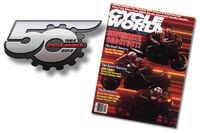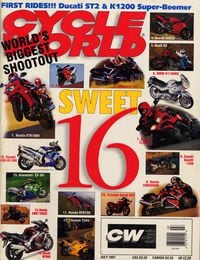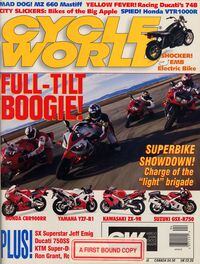October, 1972: The first time the word “superbike” appears in the modern era is in editor Ivan J. Wagar’s first-ride report on the new Kawasaki Z1. With all that power, the conjecture was that the 903cc beast’s drive chain (even with an oiler dribbling lube) wouldn’t last more than about 3500 miles: “But chains and tires seem to be the price that has to be paid for the luxury of owning the new super bikes.”
May, 1973: The Z1 is here in the flesh, literally, displayed on the cover alongside a Munch Mammoth and a thick woman whose massive endowments resemble a Cadillac package shelf. Read the cover: "The Big Berthas of Modern Day Motorcycling."
February, 1975: The urge to compare has surfaced: We square off the Kawasaki Z1B against the BMW R90/6 and the new Suzuki RE5 Rotary in a more touring-oriented contest. By being smooth, shaft-driven, not much slower than the Kawasaki—and because you could give it a complete roadside tune-up and tire change with the tools it came with—the BMW wins.
September, 1981: The Fast 45s: Honda CB750F, Kawasaki KZ750, Suzuki GS750 and Yamaha Seca 750. CW's first biggish-bike cover-story comparison cares as much about "Comfort and Utility" as it does "Performance," and at the end of the day, concludes that these are all great bikes and there are no winners, really. But maybe the Kawasaki if we're forced to pick one.
May, 1983: The New Superbikes: Honda V45 Interceptor, Kawasaki GPz750, Suzuki GS750E. "The biggest, the heaviest, the most powerful, the quickest, the fastest… The Interceptor wins."
November, 1986: Kawasaki Ninja 750, Honda VFR750, Suzuki GSX-R750, Yamaha FZ750. The racy GSX-R is slowest around the racetrack (crap rear shock), but the real test is a two-day, 500-mile street flog during which we deduce that the GSX-R is "simply not a very good streetbike. Its bars are too low, its pegs too high." Not only are the VFR and Ninja faster around Willow Springs, they're also far nicer everyday motorcycles.
September, 1988: At the end of an epic eight-bike three-way, the Yamaha FZR1000 is the
better track bike, the Kawasaki Concours the preferred sport-tourer. And the Honda Hurricane is rated the best of the bunch: “It offers all but the last few percent of the performance of the street racers, handles better than something its size really should, and still manages to do a fair job of coddling its rider.”
1993: It's too soon for a midlife crisis, but something has gotten into us by the early '90s that makes us eschew practicality in favor of performance, and when Honda lets fly the CBR900RR, something is definitely afoot. Adding light weight to a powerful motorcycle really does make the thing as racy as it looks—the CBR weighs about 100 pounds less than a GSX-R1100—and suddenly we realize a ZX-11 really isn't a sportbike at all, is it? Scott Russell wins the World Superbike Championship, and the 750 class has become a race paddock: GSX-R750, ZX-7R and a $10,500 YZF750SP!
1994: Harley-Davidson builds the VR1000 and signs Miguel Duhamel. Honda builds the $27K RC45. And when the Ducati 916 gets off the boat, we're too busy hyperventilating to notice our aching butts. Please, hurt us more…
July, 1997: Ever the voice of reason, we put the Honda VTR1000 Super Hawk at the top of a rabid pack of liter-bikes in a huge Open-class comparo called "Sweet 16," because it was comfortable and "designed for sporting street riding rather than racing." The VTR does okay in the marketplace, but the hard-edged CBR900RR and its offspring are humongous sellers worldwide for Honda for the next decade.
April, 1998: The revolutionarily lightweight, 150-claimed-horsepower Yamaha YZF-R1 blows everything else into the weeds in another Superbike Showdown, and it's not even that uncomfortable. "It's the first mass-produced, made-in-Japan Bimota." The things sell out almost instantly.
2001: Suzuki launches its GSX-R1000, and it, too, sells like cocaine hotcakes.
2004: What could Kawasaki do but drop the lovable ZX-9R and pile on with a hyperactive new ZX-10R superbike? (In 2007, Wikipedia says, the Insurance Institute of Highway Safety awarded the ZX-10R the highest collision-damage loss claim rate of any motorcycle in the U.S. Kudos…). Now, our houses are suddenly worth twice what we paid for them six months ago, and motorcycle sales are rocketing upward. In spite of outright performance virtually untappable on the street, these highly specialized high-performance machines are What's for Dinner (unless you want a Harley-Davidson, whose sales are also booming), and business keeps accelerating right through the 2008 peak.
Post-crash: Things change. Lately, many buyers have decided that playing Ewan McGregor might be more sustainable long-term than playing Valentino Rossi, and now adventure-bike sales are hot. Adventure bikes, really, are nothing more than the general-purpose bike—with SUV pretensions—that we all bought before we went collectively performance crazy. But big sportbike sales are hot again, too, so it’s way too early to predict that the era of the Superbike Shootout is over. How much more performance can we take? We’re willing to keep trying to find out!















/cloudfront-us-east-1.images.arcpublishing.com/octane/QSS5DZ6SKJEU3AKE4KDAWYBEFY.jpg)
/cloudfront-us-east-1.images.arcpublishing.com/octane/SMCEQCLWRVEFTJJES6TAHB3OOQ.jpg)
/cloudfront-us-east-1.images.arcpublishing.com/octane/JCACIDCAC5FUNPTXO2BOUHGGII.jpg)
/cloudfront-us-east-1.images.arcpublishing.com/octane/DC7ZGILA2BCJXHZIUNYGV7JSEA.jpg)
/cloudfront-us-east-1.images.arcpublishing.com/octane/EWJEZUGWEZGABDEQWB64WL46GQ.jpg)
/cloudfront-us-east-1.images.arcpublishing.com/octane/5NHBMRMSFVD5JAPFNMBMNPGXQE.jpg)
/cloudfront-us-east-1.images.arcpublishing.com/octane/WHE43SCPLJBRNANAJAGXHOAIEU.jpg)
/cloudfront-us-east-1.images.arcpublishing.com/octane/6R56AQAW6NDE7BBIJ3SMCOOY5A.jpg)
/cloudfront-us-east-1.images.arcpublishing.com/octane/JMQTUE2FKZFURJTJXDMM4V47AQ.jpg)
/cloudfront-us-east-1.images.arcpublishing.com/octane/P2QYJDMQNVEANMQFXHNB3OVFKQ.jpg)
/cloudfront-us-east-1.images.arcpublishing.com/octane/VNKGXM4AA5BPRGERJOPV6GADAQ.jpg)
/cloudfront-us-east-1.images.arcpublishing.com/octane/2WS4YIFLTNG25L25WP7ZFLSWJM.jpg)
/cloudfront-us-east-1.images.arcpublishing.com/octane/UXRS6ZVQZFC23FY2EDYNT5WMVA.jpg)
/cloudfront-us-east-1.images.arcpublishing.com/octane/7JETMCKNVRGDZIGB3JCITGLPUU.jpg)
/cloudfront-us-east-1.images.arcpublishing.com/octane/OZV6E2KNIJDVHGOKXQQ2AHKLHQ.jpg)
/cloudfront-us-east-1.images.arcpublishing.com/octane/XSKMIBFZIZDN7JC6P7SMNMD3QA.jpg)
/cloudfront-us-east-1.images.arcpublishing.com/octane/ITVHWHVQ75BQBHACERYDJLPLHE.jpg)
/cloudfront-us-east-1.images.arcpublishing.com/octane/M3QRBSQ4VFEVPKYTTM3OETVFBU.jpg)
/cloudfront-us-east-1.images.arcpublishing.com/octane/H3EMT5NJ5BDZPBBH27SW3ADQH4.jpg)
/cloudfront-us-east-1.images.arcpublishing.com/octane/XTROSHDZFJB5DIJYU2VF2REFIU.jpg)
/cloudfront-us-east-1.images.arcpublishing.com/octane/7EUSM4GQEBEFTPAYZ6MOMKMMUQ.jpg)
/cloudfront-us-east-1.images.arcpublishing.com/octane/ZN44KZLHD5CHVIY3WZYAGTPGSI.jpg)
/cloudfront-us-east-1.images.arcpublishing.com/octane/5A776WXBY5GAPDYFTTUEUZNIJA.jpg)
/cloudfront-us-east-1.images.arcpublishing.com/octane/NCYHFQ2S3BAT7EC7VDN2ONGRTU.jpg)